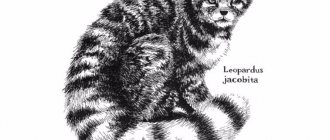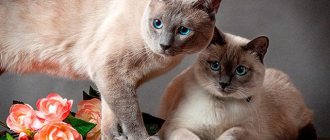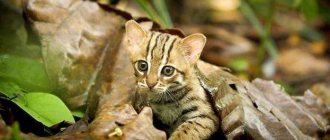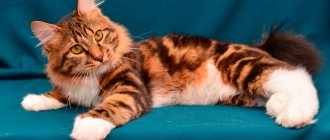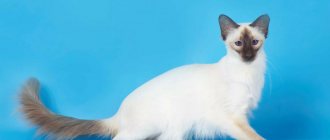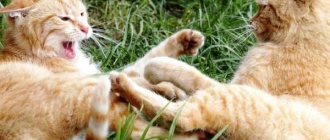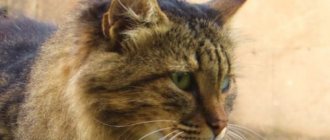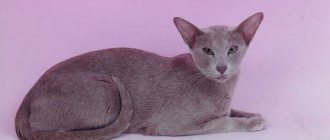Video
* We invite you to watch a video about the Chartreux . In fact, in front of you is a playlist in which you can select and watch any of 20 videos about a given cat breed by simply clicking on the button in the upper right corner of the window. In addition, the material contains quite a lot of photos. By looking at them you can find out what Chartreuse looks like.
Rate the material!
[Total votes: 0 Average: 0]
The Chartreux is a fairly rare cat breed. The simplicity of this cat is combined with elegance, and against the monochromatic background of a silky and beautiful coat, the cat’s amber eyes stand out brightly, attracting and bewitching. Let's learn more about this amazing breed, from the origins of its origins to the peculiarities of caring for these cats, having examined all the most important nuances of their life.
Rules of care and feeding
Care
The nature of their coat requires regular brushing. The fact is that Chartreuse has a thick undercoat, which tends to raise their coat. And if the fur is not combed out, it will stick out in all directions. During the shedding period, grooming should be done more often to get rid of large amounts of hair on furniture, carpeting and clothing.
The water-repellent properties of wool make the process of bathing cats a little difficult, and after bathing, owners will need a lot of time to dry it well. In addition, regularly clean your pets' ears and rinse their beautiful eyes.
Nutrition
Regarding nutrition, veterinarians recommend not combining natural and dry food in the diet. Such a diet can provoke the development of metabolic disorders. Also, it is not recommended to feed them cutlets, sausage and cheese. Spices and salt that are part of such products have a bad effect on the condition of their coat and skin.
History of the origin of Chartreuse
This cat breed is considered quite ancient. Experts believe that the ancestors of modern Chartreuse were cats that inhabited the Middle East: Mesopotamia, Syria, Palestine. During the Middle Ages, they were brought by the crusaders to Europe, to France.
This is how the cats ended up in the Grande Chartreuse monastery. The Catholic monks living there initially observed the charter of the Carthusian order, according to which it was necessary to observe a vow of silence. It would seem that cats also adhered to this vow, making almost no sounds and meowing in a whisper. It’s not for nothing that Chartreuse cats are also called Carthusian cats.
Interesting fact: The name “chartreuse” was forever assigned to these cats back in the 17th century. In the next century (18th), the name of these cats appeared on the pages of dictionaries and encyclopedias and was listed as “blue cat.” This happened thanks to the outstanding natural scientists Buffon and Linnaeus.
The development of the breed in full began only after the end of the First World War, at that time even the first exhibitions were held. But after World War II ended, the Chartreux suffered a terrible fate - they almost disappeared completely.
This amazing cat species was saved thanks to the Léger sisters, who crossed the Chartreux with British and Persian cats, although this lost some of their purebredness. Chartreux were brought to the United States only in the 70s of the last century; American breeders wanted to cross them with British shorthair cats, but, fortunately, they changed their minds, preserving the cat's purebred.
Americans fell in love with this cat breed, and nurseries began to open throughout the country. England has long considered itself the copyright holder of the breed, because the Chartreuse is very similar to the British shorthair cat. Still, France is considered the country of origin of Chartreuse.
The cat standard was last edited in 1999 by the International Feline Association (CFA). The standard notes that chartreuse has been known since the Middle Ages.
Chartreux - description of the breed
If we talk about the general description of the Chartreux, it can be noted that the cat has a fairly powerful physique. The standard marks it as primitive, i.e. it has not changed during breeding work.
The cat's body perfectly combines grace and strength, and you can add speed of reactions and agility to them. The gender differences in these cats are immediately noticeable: females are much smaller than males. The weight of males varies from 6 to 7.5 kg, females - from 4 to 5 kg. Well-developed muscles clearly appear on the stocky cat's body.
The head of the Chartreuse is very wide, in shape it resembles an inverted trapezoid. She has a high and sloping forehead, rounded and plump cheeks. The nose is straight and short in length and width. The bridge of the nose is located at the level of the cat's eyes and is of moderate severity. The entire shape of the muzzle protrudes slightly forward. The neck of the Chartreux is short, but very massive; in combination with the round, thick-cheeked face, the cat looks good-natured and seems to be smiling. The ears are of medium size, set vertically and high. The eyes are large and not endowed with a characteristic squint.
The iris can be colored in the following shades:
- Reddish yellow;
- Yellowish-brown;
- Orange-brownish;
- Amber;
- Golden;
- Bronze;
- Bright orange.
The last eye color is the most valued. The length of the cat's tail is less than the length of the entire body. At the base it is greatly thickened, towards the end it becomes narrower; experts note its mobility and special flexibility. Chartreux cannot be called long-legged; their limbs have average parameters, they are quite strong and straight, and the front legs are smaller than the hind legs.
Description of Carthusian cats
The Chartreux cat has a massive build, although many people confuse this breed with the British Shorthair; the standards clearly describe the features and characteristics of gray-blue purrs with amber eyes.
The head of an adult animal is rounded and wide. There is no pinch on the round cheeks. On the muzzle there is an absolutely straight nose of medium length. On the small, narrowed muzzle, you can see what appears to be a slight smile. A characteristic feature is the gray nose. If there is a pinkish or black tint, then the pet is not purebred.
The ears are set high and set wide apart. Visually, the ears are inclined forward, and their tips are rounded.
Round, lively eyes are characterized by shine, even tone and saturation. The description of eye color should contain only one word: amber. In the first month of life, kittens have gray-blue eyes.
global $ads_google; //data-ad-slot=”2475549904″ $ads_google = empty($ads_google) ? false : true; ?> if ($ads_google == false) {?> $ads_google = true; ?> } ?>
This powerful French cat has a very developed chest, and her round paws are no less strong. The limbs themselves are thin-boned and short, which does not conflict visually with the large muscular body.
The tail is not fluffy, but proportionate in size.
Chartreuse wool is pleasant to the touch, soft, fluffy, with a tight-fitting pile and a thick, water-repellent undercoat.
If you are prone to allergies, you should understand that there is no information about the hypoallergenic nature of the breed and cannot be.
A short-haired cat can only be blue in shades from light to dark gray.
Chartreuse dimensions and weight
Cats that are medium in size and length are inferior in size to male cats. The weight of powerful and strong males exceeds the weight of females. With an adult animal height of 30 cm, they can weigh 5 kg or more.
Typically cats, which are still shorter in height, weigh about 5 kg.
Seals are more massive and look like animals of large breeds weighing 7 kg. Table of approximate weight of Chartreuse by month
| Age | Female | Male |
| 1 month | 270-610 g | 530-750 gr |
| 2 months | 450-900 gr | 940-1450 gr |
| 3 months | 1-1.45 kg | 1.4-2.5 kg |
| 4 months | 1.6-2.5 kg | 1.7-3.7 kg |
| 5 months | 2-2.9 kg | 2-4.1 kg |
| 6 months | 2.1-3.5 kg | 2.4-4.6 kg |
| 8 months | 2.3-4 kg | 3-5.1 kg |
| 10 months | 2.5-4.2 kg | 3.8-5.8 kg |
| 1 year | 2.7-4.4 kg | 4.3-6.3 kg |
| 2 years | 3.2-5 kg | 5.2-7 kg |
What is the difference between a Chartreux and a British cat?
global $ads_google;
//data-ad-slot=”2475549904″ $ads_google = empty($ads_google) ? false : true; ?> if ($ads_google == false) {?> $ads_google = true; ?> } ?> The external similarities between two well-known cat breeds may puzzle the inexperienced buyer. What is the difference between a Chartreux and a British cat if they have very similar coats and parameters? And the fur coat plays an important role: the British can flaunt different colors, but the French can only sport blue-gray, called “Maltese”. The undercoat should also be silver-blue.
The faces of the Carthusians look like an inverted trapezoid and have a “smile”, while the Brintans have a beautiful rounded head and the same obvious cheeks.
All the confusion began when in some European clubs a British blue cat was mistakenly called a Chartreuse. This practice is still common in Germany and some other countries.
Differences between Chartreuse and Russian Blue
It is very difficult to confuse these breeds, since their characteristics differ significantly from each other. What is characteristic of the Russian Blue? Pointed tips of the ears versus rounded Cartesian ones, a different type of muzzle, no round full cheeks and no “smile”.
Also a clear difference will be the color and shape of the eyes. The Russian Blue cat has oval and almond-shaped eyes, bright green.
The tail of the Carthusian is not particularly long and does not taper towards the end, like that of the Russian Blue.
Having studied all the nuances in the description of the standards, there will be no problems with distinguishing cats.
Popular Chartreuse colors
The elegant and wonderful coat of the Chartreuse can be confidently called a cat’s calling card, because it is thanks to it that this breed is valued by many cat lovers. In general, Chartreuse cats are short-haired, but it is rare to find cats with medium-length hair. Cat fur is thick, fluffy, silky, and incredibly pleasant to the touch.
This cat breed is characterized by the presence of a rather densely packed undercoat, which makes the Chartreuse look elite, stately and attractive. The undercoat also has practical significance, protecting the mustache from cold and wind.
Interesting fact: Despite the fact that the fur of Carthusian cats is not long, they shed quite profusely, which should be kept in mind for those who are prone to allergic reactions.
There is no need to say too much specifically about the color of Carthusian felines, because it is quite laconic and uniform, but this is its nobility, a special chic that gives the cats incredible attractiveness.
The coloring of chartreuse is monochromatic blue; it can vary, having certain distinctive shades, ranging from light tones to dark, gray-blue, shimmering with silvery highlights in bright light. Some experts describe the coat color of these cats as a cool shade that can vary from blue-gray to lavender tones.
Other colors and shades are not provided by the standard. Also, there should not be any specks of white or dark colors on the fur, stripes should also be excluded, this will be considered a defect. The cat's nose in Chartreuse is dark graphite in color, and the color of the pads on the paws is grayish-pink.
Color
The calling card of the Chartreux breed is its gray-blue coat of all shades: from thick slate to light ash. Plain blue is the most flattering, but a silver tint is not prohibited. Babies often have spots of a different color on their fur, but as they grow older they disappear.
The coat color of Chartreuse cats is gray-blue in all shades.
Character and habits of Chartreuse
Naturally, each cat has its own character, in which individuality is visible, but, nevertheless, some common features are inherent in this breed, let's try to analyze them. There are three particularly pronounced qualities that Chartreuse is endowed with.
This:
- Jealousy;
- Equilibrium;
- Modesty.
Let's look at each of these three points in more detail. As for jealousy, this is precisely the trait that many owners note in Chartreux dogs. Cats will never put up with the fact that another pet will live in the house, they should feel like they are one and only, so it is not at all easy for a Chartreuse to get along with another pet, this most often does not work out, although there are exceptions. Chartreux children, having spoiled themselves, are treated with love and warmth.
Although Chartreux are playful, they know when to stop everything, they are calm and taciturn. Cats have a very quiet voice, so you shouldn’t expect violent meows from them; it seems that equanimity and balance are in their blood. Chartreuxes never get into trouble and try to avoid conflict situations. They endure various changes and inconveniences (for example, a change of place of residence). These mustaches can adapt even to prolonged loneliness.
As for modesty, it suits a Cartesian cat (more precisely, it suits its face). They are very devoted to the owner (precisely one person), having chosen him, cats become constant faithful companions, but stay a little distant so as not to seem annoying once again, Chartreux never impose themselves, showing their independence and nobility. Cats are loyal to strangers, do not show aggression, and behave quite peacefully and reservedly.
Chartreux are by nature tireless hunters, their vigilance and hearing are excellent. They perceive sounds that humans cannot understand. Cats immediately go in search of the source of this sound, sneaking up unnoticed and silently, the next stage is a well-aimed throw, with the help of which the prey (and this, most often, a mouse) is firmly pinned down. Long games with a caught trophy are not typical for Chartreuse.
Chartreux are real intellectuals; scratching everything, spoiling and breaking things is not their thing. Cats are very clean. Adult chartreuses are never averse to being lazy and taking a nap for an hour or two, which is quite typical for any ordinary, mongrel cat.
Education and training
Chartreuses have an inquisitive mind and rare insight. It is not difficult for them to use the switch, open the water tap, and even press the door handle to leave the room. The intelligence of cats makes the training process easier. With your help, the “Carthusians” will learn good manners, easily get used to using a scratching post and litter box, and will not refuse to be walked on a harness. Train your pet from the first day it appears in your home, since training an adult Chartreuse will take more time and effort, and the result will be far from perfect.
As for training, you will have to forget about traditional commands. Representatives of the breed consider it beneath their dignity to jump at someone’s direction, overcome an obstacle course and somersault. However, Carthusian cats easily get used to their nickname and even bring abandoned objects or toys to their owner. The main thing is not to raise your voice at your pet, otherwise his furry majesty will not forgive you for such insolence.
Interesting facts about Chartreuse
There are many interesting stories and facts about such amazing cats, which we will try to present, choosing the most fascinating ones. Maybe they will encourage many to get themselves such an attractive mustachioed pet.
So, the most interesting facts about Chartez cats:
- Chartreux is considered a fairly ancient breed; scientists have proven that they were first mentioned in the 16th century;
- Chartreux cats are similar to British Shorthair cats, so the breeds can easily be confused. Until 1977, these two cat varieties were considered one breed, but after they became separated, thus emphasizing the fact that these are different types of cats. The French treat Chartreuse as a national treasure;
- Even Charles de Gaulle had a mustachioed favorite Chartreuse; he greatly appreciated his refined appearance and the habits of a real aristocrat;
- Surprisingly, today the majority of purebred Chartreuse live on the American continent, and not in France;
- In addition to the cat breed, “chartreuse” is also called a famous liqueur infused with medicinal herbs. Its recipe was also developed by the monks of the Chartreuse monastery;
- The color of the Chartreuse's undercoat differs from the overall tone of the coat; it looks darker. The skin of the animal also has a bluish color;
- Under severe stress, Chartreuse cats may begin to lose their hair, so you need to take care of the cat’s nerves so that the animal does not turn into a Sphynx cat;
- They say that the Chartreux owes its silence to the monks of the same monastery, who kept a vow of silence, and the mustachioed pets also began to follow this principle, accustomed to meowing rarely and quietly;
- In France, on the territory of the Savoie department, there is a mountain named after the Chartreuse “Mountain of Gray Cats”;
- The Carthusian monks dedicated many poems to these amazing feline creatures.
Peculiarities
Chartreuse eyes are especially expressive: large and bright, they have a yellow, orange or copper color. Their nose is straight and upturned, their ears are small and set high.
And the cone-shaped muzzle creates a mysterious smile. But who knows, maybe your pet really smiles at you?
Pros and cons of Chartreuse
Like any other animal, Chartreuse has its own characteristics. Many owners do not notice any shortcomings in these cats, because they adore them immensely. Looking at Chartreuse from the outside, you can see both the pros and cons; we will try to list them. This may help those who are planning to get such a cat.
Cat's virtues:
- Possessing a calm and obedient character;
- Boundless devotion to the owner;
- Magnificent and noble appearance;
- Delicacy and unobtrusiveness, chartreuse certainly won’t bother you;
- A quiet voice that you rarely hear;
- Cleanliness;
- Presence of intelligence and intellectual development;
- They get along well with children and don’t mind tinkering with them;
- Magnificent and passionate hunters;
- Unpretentious regarding care;
- Avoid conflicts;
- Independent and adapt well to any new conditions;
- They are the owners of fairly good health.
Disadvantages of the breed:
- Rarity, and therefore overpriced;
- Subject to heavy and frequent shedding, which can cause allergic reactions;
- Very similar to the British Smooth-haired;
- They are often obese, so you need to carefully monitor your diet;
- They may show excessive autonomy and independence;
- They do not like long and excessive caresses;
- Jealous of other pets, it is preferable that there are none at all;
- They do not like to live in a specific designated place, considering the entire house to be their territory and moving freely around it;
- Aversion to water procedures, which are not easy to carry out in autumn.
Advantages and disadvantages
Carthusian cats are not very common, even in France their numbers are small. This is completely undeserved, because such a pet is extremely unpretentious in maintenance. Due to their calm and passive nature, they can be kept even in a one-room apartment, which will not cause inconvenience to either the pet or its owners.
In a private home, he is also an indispensable assistant - rodents often live there, and this breed of cat is a renowned rat catcher.
Breeding Chartreux
Chartreux become sexually mature at the age of one year or even closer to one and a half years. It has been noticed that the maturation of cats is slightly delayed compared to females. The main thing for mating is the moment of selecting a worthy partner, which is very difficult due to the great rarity of these cats.
An important factor here is not only the presence of an excellent pedigree, but also the excellent health of both mustachioed partners. It’s worth noting right away that breeding Chartreux in our country is not possible, because these cats are mainly bred in the USA and France; breeding individuals are not exported outside these countries, so kittens that are already castrated or sterilized come to Russia. You can find out below how the mating process works in the above-mentioned countries.
For mating, the cat is brought to the territory of the male so that the latter feels confident and is not afraid of anything. Experts recommend leaving the female to stay with the cat for a couple of days to ensure a guaranteed pregnancy of the cat, which lasts for two months. Usually, there are 2 - 4 kittens in a litter, very rarely there are 5 babies. Most often, Chartreuses themselves cope well with all the difficulties associated with childbirth, so it is quite possible to do without medical help, of course, if no complications are observed.
In the first weeks of life, kittens need only maternal warmth and breast milk. At this time, only the mother cat should take care of the babies’ nutrition, and owners should only take care of feeding her, providing all the necessary vitamins and minerals. Kittens become sighted between 7 and 10 days of age; their development rate can be called moderate.
Closer to the age of one month, they are already quite capable of going to the litter box. At six weeks they begin to wash themselves, communicate more vividly with each other, behaving like adult relatives, at the same time they acquire their noble and refined coloring. Three months of age is considered the best time to hand over grown babies to new owners. It should be added that the average lifespan of Chartreuse is 12 years, but there are specimens that lived up to 16.
How to choose the right kitten
Chartreux are quite rare and expensive animals. Therefore, it is advisable to buy kittens of the Carthusian breed in specialized nurseries or from trusted breeders with a good reputation. Before purchasing, it is important to make sure that small chartreuses are kept clean and have all the necessary documents.
Having dealt with the papers, you can pay attention to the appearance of the Carthusians themselves. The purebred three-month-old kitten has a proportional, strong build, orange eyes and the correct gray-blue color.
A healthy little Chartreux should have clean ears, smooth skin without scratching, a soft belly and a good appetite. He shows no signs of cowardice and is actively interested in everything that happens around him.
Kitten care
Conscientious breeders begin transferring small Chartreux dogs to new owners after they are 3 months old. By this age, Carthusian kittens not only know how to eat on their own, but also know a tray with a scratching post. Therefore, new owners can only show the pet the location of the toilet, scratching post and bowls of food and water.
The little Carthusian is no less curious than a kitten of any other breed. To prevent him from harming himself, wires, indoor plants, household chemicals, and small and fragile objects are hidden from him.
Caring for Chartreuse
Carthusian cats cannot be called picky; they do not require any privileged conditions, they are unpretentious in care, which is good news. Naturally, it is necessary to take care of mustachioed pets by carefully monitoring their appearance, behavior and carrying out certain hygiene procedures.
Important fact: You should definitely pay attention to the cat's fur coat; to do this, you need to comb it at least once a week, or more often, cats really like this massage. When Chartreuse sheds, this must be done constantly and with a coarser brush.
Cat teeth are also cleaned weekly using a special, coarse brush and paste for animals. Such dental procedures not only remove food particles, but also eliminate the appearance of tartar. Cat's eyes also require care; they need to be washed with tea or a special product using a soft cloth or cotton pads, the main thing is that they do not leave lint.
A couple of times per month you need to inspect your ears, wiping them from the inside with a cotton pad dipped in water. This is not to the liking of the Chartreuse, so you need to show remarkable skill and accuracy. Cats should have their nails trimmed once a month using a special nail clipper; only the very ends need to be trimmed.
With water procedures, things are not so rosy; it is not recommended to bathe Chartreuse dogs more than once or a couple of times a year, and doing so is extremely problematic. Cats hate bathing and are very impatient with it and can become aggressive. It is not easy to wash their tightly packed wool, and it takes a long time to dry.
As for arranging a specific cat’s place in the home, Chartreux does not need this; they will independently choose an area for relaxation, because restrictions and closed doors irritate them. Carthusian cats love free movement around the house, because they consider it their property. Chartreuse dogs can be trained to walk outside, they simply love it, but they prefer independent movement rather than using a leash or harness, although they also get used to these accessories.
Vaccinations and antiparasitic treatment
All domestic cats are susceptible to viral infections. To protect the Carthusian from premature death, he is regularly vaccinated:
- from calcivirosis;
- rhinotracheitis;
- panleukopenia.
The Carthusian kitten is first vaccinated at the age of 7-8 weeks. After 4 weeks, the vaccination is repeated, but with an anti-rabies component. Subsequently, the Chartreuse is vaccinated annually.
To protect the Chartreux from diseases carried by parasites, it is regularly treated for fleas and helminths. Antihelminthic tablets are given to Carthusian cats once every six months and repeated after 10-14 days.
For flea treatment, special drops and shampoos are used. And if the Chartreux regularly goes outside, he is additionally protected with an anti-parasitic collar.
Chartreuse diet
Chartreux cats are not picky about food, cats have an excellent appetite, and this breed is prone to obesity. Therefore, experts recommend feeding cats with high-quality dry food, where all the necessary vitamin and mineral elements are balanced. Of course, only the owner decides what his pet’s food will be: natural or dry food (you cannot combine).
Food from the human table is not suitable for Chartreuse. Salt, spices, fatty and fried foods are contraindicated for them. Pork, smoked meats, and all sorts of highly salted junk foods should be excluded from the cat’s menu.
First of all, Carthusian cats should be given:
- Lean rabbit meat;
- Chicken;
- Turkey;
- Beef.
All of the above meat products are best boiled or thoroughly frozen. It is not often that cats can be treated to boiled sea fish; it is better that there are as few bones in it as possible. Instead of cereal porridges, experts recommend vegetable side dishes for these cats; Chartreuse cats are not averse to eating pumpkin, zucchini, cauliflower, and zucchini.
Fermented milk products, such as fermented baked milk or kefir, are also very useful for mustaches, but it is better to avoid milk, it is poorly digested and can cause stomach upset. Boiled chicken or quail eggs should be given once a week. They are especially useful for kittens, who are also fed cottage cheese.
There is no need to overdo it with portion sizes, do not fall for the tricks of cats looking at you with hungry eyes, remember the tendency to be overweight. Of course, you shouldn’t forget about water; access to it should be around the clock, especially if the cat eats dry food. It is better to use bottled water, but tap water will do, you just need to let it sit for about 6 to 8 hours.
Diseases and health problems
Carthusian cats have a strong immune system, so they are not susceptible to attacks from various viral diseases, but they do have some congenital problems. These include dislocations of the kneecaps, which are the most common. This can lead the cat to lameness and weakness of the hind legs; such cats are discarded from the reproduction process.
Important fact: A disease such as hip dysplasia is also characteristic of Chartreuse, it can be completely stopped or its progression can be significantly slowed down if you consult a veterinarian in time.
Felines can suffer from gingivitis, which can be dangerous to their teeth, so weekly brushing and regular checkups are essential. Every year, the veterinary clinic needs to remove tartar, if any. Don’t forget that Chartreuse cats are susceptible to obesity, so choose their diet carefully and do not overfeed, because excess weight in cats can also affect the cat’s cardiovascular system, which is very dangerous.
In general, chartreuses are very strong, quite hardy, strong not only in body, but also in spirit. It’s not for nothing that they lived in the monastery from ancient times. Of no small importance for the cat’s health is the care of the owner, which consists not only of constant monitoring of the pet, but also of timely vaccination and deworming procedures so that the mustachioed pet feels needed, happy, and most importantly, healthy.
As you know, the best talisman against all illnesses is their prevention, thanks to which you can identify the disease at an early stage, easily cure it, and in many cases, ailments and problems can be completely avoided.
Choice of kitten and price
Chartreuse is considered a small breed; even in their homeland in France they are not widespread. In any case, it is possible to find a nursery or individual breeders breeding the breed.
You should definitely find out about the availability of documents for the animal and its pedigree. Due to their similarity with some breeds, for example, the British Smoothhair, you need to be especially careful when choosing a kitten. Under the guise of Chartreuse, scammers sell outbred or other breeds of animals.
The cost of such a kitten is from 20,000 rubles. as a pet. An animal for breeding or exhibitions is much more expensive.
